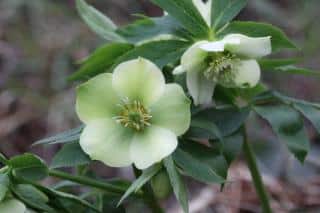

If you’re looking for one of those elusive rare flowers that bloom in winter, then hellebore is an excellent pick! Christmas magic comes alive with this rose-like flower!
From the 15 or so hellebore species, the Christmas rose is also known as Helleborus niger, the black hellebore, and even the white-flowered hellebore (roots are what is black, giving the plant its name!). This delicate but hardy flower blooms from December up to the start of spring. Throughout the year, thick, deep green leaves give the plant a noble appearance, which the blooming elegantly complements: 5 sepals form each cup-shaped flower.
A thick layer of snow won’t keep this one from blooming: even in the coldest weather, it still bursts through. No wonder it is a symbol of strength and hope! A Christmas legend shares a beautiful story about the origins of hellebore: a poor shepherdess went to see baby Jesus when he was still in the manger. Being poor, she had nothing to offer, and wept. Angels saw her plight and transformed her tears into magical flowers for her to give.
The other well-known hellebore is Helleborus orientalis, the Lenten Rose. It features exceptionally long blooming, and can cope with drought. It’s the easiest of all to care for.
To this day, new hybrids have extended the range of colors of these flowers, starting from the natural pink-spotted white, to purple and even green for Helleborus argutifolius. This year, two recent hybrids are on the market. They bring together the best of both species: the “Madame Lemonnier” is pink, and the “Paradenia” is white.
You’ll find some hellebores growing in the wild if you go hiking in the mountains. In the Alps, for instance, they thrive naturally in shaded valleys. Note that they’re all protected species, not fit for picking, and on top of that they’re highly toxic.
As a general rule, it loves shade or part shade, and soil that’s rich, cool, stays heavy and nonetheless drains well. It can’t cope with drought, so you’ll have to mulch around it. Experts in caring for perennials recommend spreading a layer of compost right at the base of the plant, and then stack dead leaves around that. Other options include flax or bark mulch.
Fabulous in the garden, perfect for “forest underbrush”-type settings, hellebore additionally does great in pots, as long as it’s outdoors and in the shade (balcony, terrace, deck, windowsill…). Bring them indoors for a few days at a time during Christmas to decorate the house, preferably in rooms that aren’t too warm, such as the lobby or the winter garden. After that, bring them back outdoors, but do this gradually to avoid temperature shock.

One tip is to cut older leaves off so that it’s easier for younger leaves to sprout. If you decide to not deadhead wilted flowers, your hellebore will bear seeds and sprout again a little further off, all on its own. Let it spread naturally, or unearth some of the seedlings to move them to another spot or give to neighbors and friends.
Some species, however, are deciduous: Helleborus atrorubens and H. cyclophyllus, for instance.
Claire Lelong-Lehoang